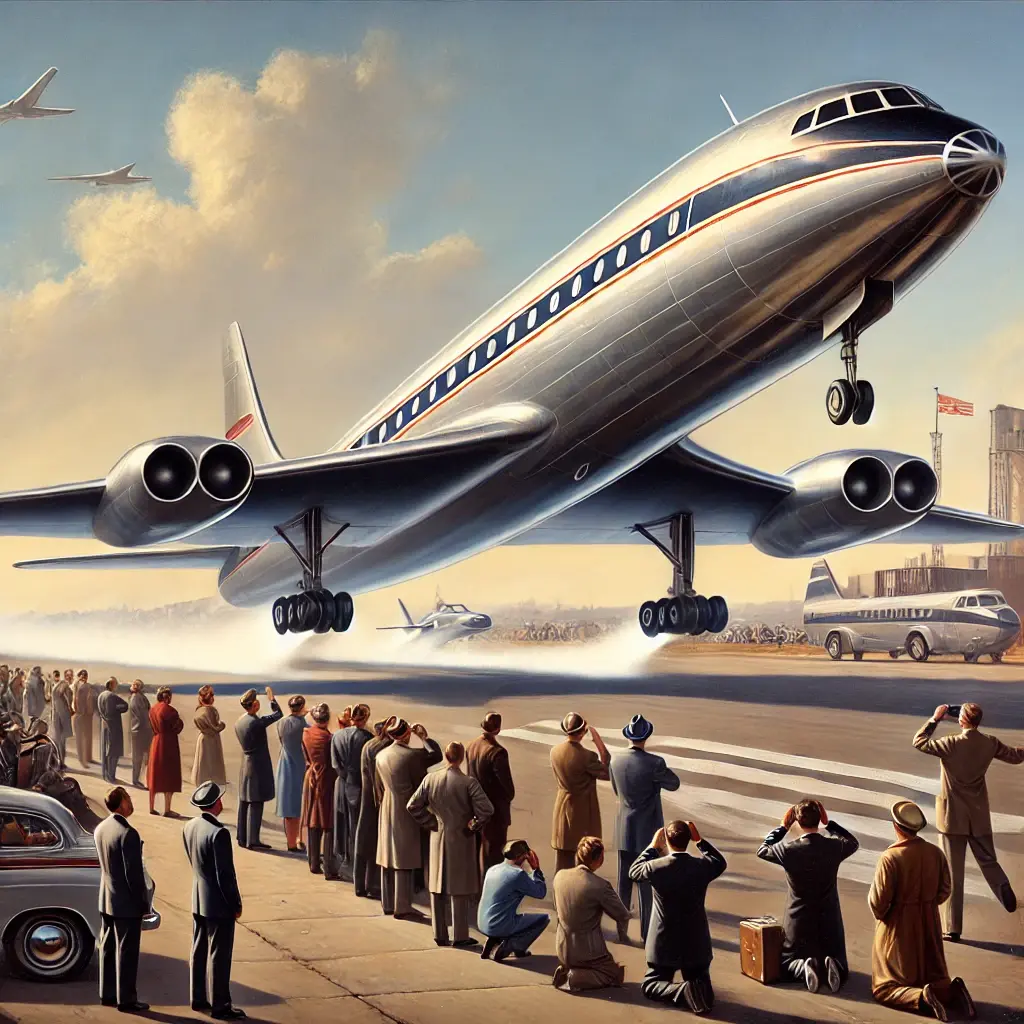On July 27, 1949, the de Havilland Comet, the world’s first commercial jet airliner, made its maiden test flight, heralding a new era in aviation. Designed and built by the British, the Comet revolutionized air travel by significantly reducing flight times and changing the nature of commercial aviation. Its introduction marked the beginning of jet passenger service, which would eventually become the standard for global air travel, profoundly influencing both commercial aviation and international connectivity.

The maiden test flight of the de Havilland Comet on July 27, 1949, marked a monumental breakthrough in the history of aviation. As the world’s first commercial jet airliner, the Comet represented a significant leap forward from the propeller-driven aircraft that had dominated commercial air travel. This British-designed marvel was poised to change the dynamics of the aviation industry by offering unprecedented speed, comfort, and efficiency.
The development of the Comet began in the aftermath of World War II, as de Havilland sought to capitalize on advancements in jet engine technology. The vision was to create a commercial airliner that could fly higher and faster than any of its predecessors. The Comet’s sleek design, featuring a pressurized cabin and four turbojet engines, was a bold departure from the conventional aircraft of the time. The pressurized cabin allowed it to cruise at higher altitudes, offering a smoother and quieter ride above turbulent weather conditions.
The successful test flight in 1949 demonstrated the feasibility of commercial jet travel and set the stage for its introduction to the public. The Comet’s performance during this initial flight impressed aviation experts and generated excitement within the industry. Its ability to significantly reduce flight times was a game-changer, making long-haul travel more accessible and convenient for passengers.
The introduction of the Comet into commercial service in 1952 was met with great enthusiasm. It began operating routes for the British Overseas Airways Corporation (BOAC), offering faster travel times between major cities and reducing transatlantic flight durations considerably. Passengers marveled at the jet’s smoothness and the novelty of traveling at speeds previously reserved for military aircraft. The Comet’s arrival marked the beginning of the jet age, transforming the aviation landscape and setting new standards for passenger service.
However, the Comet’s early years were not without challenges. In 1954, a series of tragic accidents involving the Comet raised serious concerns about its safety. The aircraft experienced catastrophic structural failures, leading to several crashes and the temporary grounding of the fleet. These incidents prompted an extensive investigation, which revealed that the metal fatigue caused by repeated pressurization cycles was the primary cause of the accidents.
The lessons learned from these early setbacks were instrumental in advancing aviation safety. The investigations led to significant improvements in aircraft design and construction, including the development of new materials and techniques to better withstand the stresses of pressurized flight. The knowledge gained from the Comet’s issues contributed to the safer, more reliable jets that followed.
Despite its initial problems, the de Havilland Comet’s legacy endured. The improvements made to address its flaws laid the groundwork for the next generation of jet airliners. Competing manufacturers took note of the Comet’s innovative features and incorporated similar technologies into their designs. This competitive environment spurred rapid advancements in jet aviation, leading to the development of iconic aircraft such as the Boeing 707 and the Douglas DC-8.
The advent of jet airliners like the Comet revolutionized international travel. The ability to fly faster and further than ever before shrank the world, making distant destinations more accessible. This new era of global connectivity had profound economic, cultural, and social implications. Tourism boomed as travelers took advantage of shorter flight times and increased route options. Business travel also expanded, facilitating international commerce and fostering closer ties between nations.
The impact of the Comet extended beyond the aviation industry. It symbolized a post-war era of technological optimism and progress, capturing the public’s imagination. The sleek, futuristic design of the jet epitomized the spirit of innovation that defined the mid-20th century. The success of the Comet and subsequent jet airliners contributed to the rise of commercial aviation as a cornerstone of modern life.
The Comet’s influence can still be seen in today’s aviation industry. Modern jetliners owe much to the pioneering efforts of the de Havilland engineers and the lessons learned from the Comet’s development. Advances in aerodynamics, materials science, and jet engine technology have their roots in the challenges and triumphs of the early jet age. The Comet’s legacy is a testament to the importance of pushing the boundaries of what is possible and the enduring impact of technological innovation.
As we reflect on the history of the de Havilland Comet, it is clear that its maiden test flight on July 27, 1949, was more than just a milestone in aviation; it was a catalyst for a transformation that continues to shape our world. The Comet’s journey from innovation to adversity and eventual triumph underscores the resilience and ingenuity of those who dared to dream of a faster, more connected world. Its story is a reminder of the power of human creativity and the relentless pursuit of progress that drives us forward.
The Comet’s introduction also highlighted the importance of rigorous testing and continuous improvement in engineering. The lessons learned from its early failures underscored the need for ongoing research and development to ensure the safety and reliability of new technologies. This commitment to excellence has been a guiding principle in aviation ever since, leading to the highly advanced and safe air travel we enjoy today.
In commemorating the de Havilland Comet’s first test flight, we celebrate not only a technological achievement but also the spirit of exploration and innovation that it represents. The Comet’s story is one of visionary thinking, bold experimentation, and the relentless quest to push beyond the limits of the known world. It serves as an inspiration for future generations of engineers, scientists, and dreamers who continue to explore the skies and beyond.
